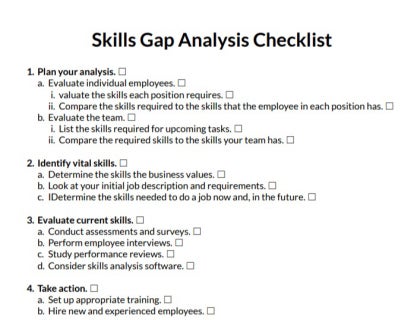
Skills Gap Analysis Checklist Download:
Stay on task and download our detailed checklist.
Download NowSkills Gap Analysis Checklist:
1. Plan your analysis.
a. Evaluate individual employees.
i. Evaluate the skills each position requires.
ii. Compare the skills required to the skills that the employee in each position has.
b. Evaluate the team.
i. List the skills required for upcoming tasks.
ii. Compare the required skills to the skills your team has.
2. Identify vital skills.
a. Determine the skills the business values.
b. Look at your initial job description and requirements.
c. Determine the skills needed to do a job now and, in the future.
3. Evaluate current skills.
a. Conduct assessments and surveys.
b. Perform employee interviews.
c. Study performance reviews.
d. Consider skills analysis software.
4. Take action.
a. Set up appropriate training.
b. Hire new and experienced employees.
What is the importance of a skills gap analysis?
A skills gap analysis will help you recognize the skills you will need to meet your business objectives. In addition, it can inform your employee development and hiring programs about potential shortfalls.
How To Effectively Bridge The Skills Gap:
1. Be transparent with job requirements.
Once your job description is more transparent and detailed, you will attract candidates with the appropriate experience and skills set. Instead of only describing jobs by traditional standards, list out each skill required, as well as the courses that would aid prospective candidates.
2. Identify the skills needed in your business.
Start by evaluating the experience and current skills of your employees, then identify future needs. Are your employees equipped with the right skills to adapt to new technology? How easily do your employees adapt to a new task?
By evaluating current skills, you will get an idea of the various skills that are required for specific jobs and what emerging skills will become important in order to grow.
3. Retrain current employees.
There are many benefits to investing in your current workforce. Retraining employees with new skills will help save you money on recruiting, develop your employees' skills, improve loyalty, and help your employees grow with your business.
You may want to reskill employees to prepare them for a new role or upskill them to improve their performance in an existing role. Given the advancement of technology and the proliferation of digital tools and processes in the workplace, providing digital skills training should be a priority for many employers.
4. Recruit candidates to fill skills gaps.
While headhunting, also referred to as executive search, is a recruitment method typically used to find candidates for senior and executive roles in companies, it is also useful for finding candidates to fill a specific skills gap fast.
Creating a positive and engaging candidate experience and investing in employer branding campaigns are also powerful tools for attracting great candidates and building a strong talent pool.
5. Develop and maintain a training program.
As your business and industry change, skill requirements will not stay the same. You will need a training program for the skills that cannot be taught at university or college.
You have the option of creating an internal training program or partnering with an outside organization. These programs ensure that your new and current employees will be able to better their skills over time.
6. Create relationships with the educational community.
Your future employees are still studying and learning the essential skills needed to enter your business field. To help better prepare this future generation of employees, build relationships with universities and colleges. Inform them about the skills your business requires and what you will expect from future graduates.
Top 15 Recruiting Trends for 2024


